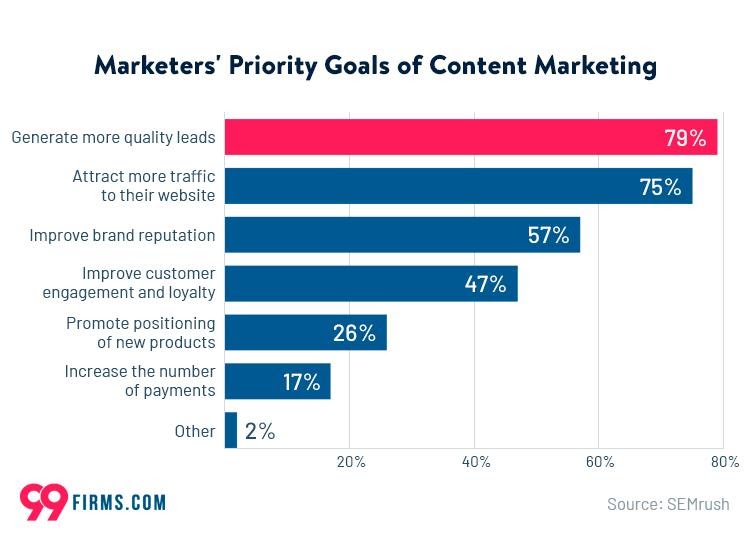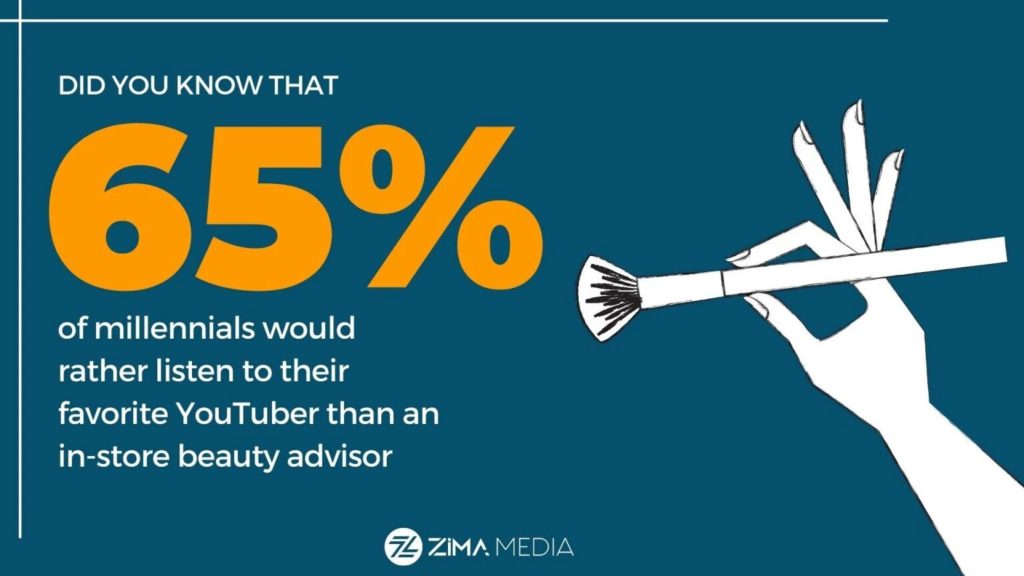8 Best Content Marketing Tips to Promote Your Beauty Brand

Table of Contents
- Why Do You Need Content Marketing for Your Beauty Brand?
- How Content Marketing Benefits Beauty Brands
- 8 Effective Content Marketing Tips for Beauty Brands
- Key Takeaways
- Conclusion
- FAQs
In today’s internet-driven world, content marketing has become a crucial marketing strategy for several e-commerce industries. And the beauty and personal care sectors are not an exception. Consumers, today, know what they want. Thus, upcoming beauty brands need to create and deliver content that caters to their specific needs. In this blog, we will take a look at some of the best content marketing tips that you can leverage to build a reputation for your beauty brand.
Why Do You Need Content Marketing for Your Beauty Brand?
The internet has been one of the primary growth drivers for the beauty and personal care industries in the recent few years. And post the COVID-19 pandemic, it has helped beauty brands spring to their feet and resume their operations.
L’Oréal, one of the world’s leading cosmetics conglomerates, mentioned in its 2020 annual revenue report that its digital sales grew by 62% in the fourth quarter of the year. Jean-Paul Agon, chairman and CEO of L’Oréal, credited the brand’s stellar online sales numbers to its “strength in digital and e-commerce”.
Glossier is another example of how a beauty brand used content marketing to score big. It is a digital-first, skin-friendly cosmetics brand that commenced its journey with a beauty blog started by its founder and CEO Emily Weiss. It emphasizes operating on a “consumer first” model. According to Glossier’s CFO Henry Davis, content is the main driver of glossier’s sales. The brand uses its content to carefully blend its product offerings with the pain points of its consumers. Thanks to this approach, the brand was able to clock good sales figures even during the pandemic. As of 2022, Glossier’s Instagram handle enjoys a respectable follower base of 2.6 million, implying that people have subscribed vehemently to the beauty firm’s business approach.
L’Oréal and Glossier’s growth, even during the trying times of the COVID-19 pandemic, is one of the several success stories that quite a few beauty and healthcare brands share. And all these success stories point towards one fact: a strong content marketing strategy is crucial to a beauty brand’s growth on the internet.
Now that you know how impactful a great content strategy can be, it is time to address the elephant in the room: does your brand need one? If yes, how can you create one? You might already know the answer to the first question, but the latter is more complex. And to get a detailed answer to the second question, you need to know what benefits an impressive content marketing strategy can bring to your beauty brand.
How Content Marketing Benefits Beauty Brands
When it comes to creating content marketing strategies, all businesses aim to build one that can significantly grow their engagement on the internet. However, “growth” is a broad term. And its definition for each business is different. Every business has certain expectations when it devises a content marketing strategy. These expectations might concern simple goals, such as increased footfall, better brand presence, or more concrete goals, such as advertising the launch of a new product. Check out these statistics to understand what we mean.

But, no matter the targets, there are certain benefits that each business enjoys after employing a successful content marketing strategy. To help you out, listed below are some major advantages a beauty business can enjoy by adopting a first-class marketing strategy.
1. More web traffic
One of the most visible results of employing a content marketing strategy is that you will observe a surge in the number of visitors to your website. When you create and distribute carefully thought-out content, it attracts consumers to explore your website. And more traffic means more conversions.
2. High-quality leads
When more people flock to your business’ website, the chances of consumers genuinely looking for the services you provide are heightened. A surge in quality leads for your brand is also a tried-and-tested metric to examine the accuracy of your content strategy.
3. Consumers stick around for a longer time
One of the core benefits of a successful content strategy is that it increases customer retention. Offering relevant content consistently to your target audiences tells them that you care for their needs, compelling them to turn into repeat buyers, and ultimately, loyal customers.
4. Increased sales
More traffic means better leads. And better leads, in turn, lead to increased sales.
5. Improved brand authority and consumer trust
When you regularly publish high-quality content on various topics on your website, you provide your users with more engagement opportunities. This results in regular and new customers turning to your brand’s website when they want to educate themselves on a topic that your business specializes in. This helps build consumer trust and establishes the authority of your brand in your niche.
Take, for example, BigCommerce, a leading e-commerce service provider. BigCommerce is a force to reckon with when it comes to delivering SaaS services to businesses. However, it’s not only the software services, but also the expertise on various e-commerce topics that make BigCommerce what it is. BigCommerce’s blog section provides insightful information on various fundamentals and intricacies related to e-commerce, essentially implying the significance of relevant content directed towards consumers.
6. Better adaptability to market trends
Beauty, along with fashion, is an industry that is more susceptible to sudden market changes. Every day, a new brand comes into the picture, new trends kick-start, and old ones fade away in the blink of an eye. And running a business in such a tumultuous environment can get difficult. But not when you have a remarkable content marketing strategy.
A good strategy has buffer points for unprecedented phenomena and is flexible enough to accommodate new market changes without much difficulty. Thus, when you see a new trend in the making, you can always alter your current strategy to abide by the new norms instead of devising a new one from scratch.
These were the major benefits that a first-rate content marketing strategy delivers. By now, you would have understood the importance of content marketing for your beauty brand. Next, let’s take a look at some content marketing tips that you can use to craft the perfect marketing strategy for your brand.

8 Effective Content Marketing Tips for Beauty Brands
An effective content marketing strategy is good for both short-term and long-term business goals. However, for a content marketer, the possibility of getting a strategy right in the very first attempt is somewhat rare. Creating a content strategy is all about deciding on a blueprint and then making a series of changes to improve its efficacy.
In this article, we have compiled some of our favorite content marketing tips for your beauty brand that can take your content strategy to new heights. Follow these tips for effective content marketing.
1. Avoid using too many distribution channels
When you promote a brand, it is quite tempting to use different media to get the word for your brand out. A few people will even suggest that you hop on to as many channels as possible to increase reach. After all, you want to educate the maximum number of people about your brand.
However, choosing multiple distribution channels such as blogs, social media platforms, emails, influencer marketing, paid ads, etc., in a bid to reach out to more consumers can prove to be detrimental to your marketing efforts. Why? Because when you resort to utilizing various distribution channels at once, what you are doing is spreading yourself too thin. Having multiple channels in your marketing arsenal will only prevent you from focusing on delivering precise content to your audience.
This is not to say that multiple distribution channels are bad. What we are implying is that you need to choose a few channels that your target audience prefers most, and perfect content creation for them. Then move on to more channels. For example, Glossier started its journey with a blog, and today, it is in a position to utilize as many content distribution channels as it wants.
2. Embrace interactive content
Interactive content is one of the best content marketing tips to increase consumer engagement. When you post good content, you want your audience to consume it wholly. In short, you want your content to be more impactful. And what’s a better way to do it than by making it interactive? When people interact with your carefully curated content, you know they will remember it for a far longer time.

Interactive content, or content that compels users to interact with it, is not new. A popular instance (and arguably, the first of its kind) of interactive marketing appeared in 1994, when AT&T bought a banner on Hotwired.com, as part of its ad campaign. The banner, a small black rectangle, posed the question, “Have you ever clicked your mouse right here?”, with an arrow pointing to text that read, “You will”, instigating users to click on the banner. According to reports, about 44% of people clicked on the banner ad.
Interactive content can range from anything as simple as quizzes to more complicated formats, such as interactive infographics. A popular example of how companies use interactive marketing is the loan calculators provided by several financial firms on their websites. Branded games are also a great way of involving users deeply in the content.
3. Consider using more long-form content
According to a study conducted by Backlinko, long-form content accounts for 77% more backlinks than its short-form counterpart. Although the study is a bit old, the sentiments of search engines towards long-form content haven’t faltered even slightly. Hence, it is no wonder that marketers, today, are still betting on long-form content as a core element of their marketing strategies.3.
Long-form content is crucial for SEO. Since writers can fit more relevant keywords in a long blog post, the chances of attracting more web traffic increase significantly. However, this doesn’t mean you should cram keywords into your blogs. Realistically, keywords should not form more than 2-4% of the entire word count. Long-form content such as case studies, blogs, white papers, etc., is useful, as it educates people on various topics. When people decide to explore a topic in depth, they resort to long blogs and the ilk. Hence, long-form content is integral to any list of effective content marketing tips.
4. Focus on SEO-optimized content
One of the more commonplace content marketing tips every content marketer, amateur or veteran, offers is to prioritize creating content that is SEO-friendly. SEO is a powerful metric that actively dictates the search engine rankings of your website.
Since buyers are extremely dependent on the internet for making a purchase, it becomes all the more necessary for a brand to have a formidable presence on the web. And SEO does just that. When you consistently publish content that is optimized for the web, you get better search engine visibility, higher search engine rankings, and increased reachability.
SEO involves not just content optimization, but also optimizing your web pages. Hence, when you devise a content marketing strategy, make sure to include SEO in your checklist.
5. Leverage the power of user-generated content
Prior to making any purchase, it is the norm for users to check out hundreds of reviews and testimonials to verify their decision. And when other users review a product or a service, they are more bound to believe their words than the garish claims of a company. This implies user-generated content holds immense power when it comes to appealing to the interests of the masses.
User-generated content is a commendable way to establish trust among your consumer base. It also provides you with ample information about what your audience actually wants. So whenever you deploy your content strategy, make sure to add a lot of user reviews and testimonials. However, you need to make sure that all your user-generated content is organic. You do not want to post fake reviews on your website to garner attention. Doing so can be detrimental to your content strategy, as well as your brand’s image and reputation.
6. Don’t sleep on influencer marketing
If you have a favorite YouTuber, you must have seen them promote products of different brands in their videos. This is known as influencer marketing. Influencers are highly popular internet celebrities that have a massive following on several social media platforms such as Instagram, Facebook, Snapchat and video sites such as YouTube. And when you appoint them to spread the word for your products, chances are, a great number of their followers will rush to buy them. Some will do so because their favorite influencer is using the product, while others may go with a recommendation from the influencer to buy a product they really need.
Influencers can be divided into various categories. The more popular ones have followers running in millions, while others (known as micro-influencers) have a small but dedicated following. If your budget is big, you can go for the more popular ones. However, if you can’t

afford to pay the exorbitant fee that celebrity influencers demand, going for micro-influencers isn’t a bad option. Experts suggest that micro-influencers provide better ROI. The logic: micro-influencers have a more tightly knit community of followers.
7. Don’t compromise in the aesthetics department
For a beauty brand, the relevance of its content is as important as its aesthetics. No matter how valuable the content is, if it is not catchy enough, not many people will take a look at it.
If you examine any big beauty brand’s website and social media handles, you will see images of beautiful people striking various poses against eye-pleasing backdrops. All these images are a part of these firms’ content marketing strategies.
And we want you to jump on the bandwagon too. No, we are not telling you to mime their strategies. What we are implying is that you need to invest more in aesthetics. Do not hesitate to hire a good photographer and visual artist, if need be. You want your content to look trendy and resonate with the preferences of your target audience. When the consumers find your content visually enticing, they will surely pay attention to your brand.
8. Never look down upon collaborative marketing
Collaborative marketing refers to when two or more brands (usually two) work together towards a common initiative. The initiatives can range from something as basic as increasing an audience base to something as complicated and time-consuming as designing a brand-new product.
Whatever the reasons are, collaborative marketing is a great strategy to increase your brand’s reach, acquire new customers, and instill a trusty brand image in your followers. Also, collaborations are fun, not just for the audience but also for the entities participating. Collaborative marketing allows you to engage with different mindsets and viewpoints by mingling with other people from the same industry. This allows you to develop new perspectives towards your brand, and learn some industry best practices that you may not be aware of otherwise.
Key Takeaways
- Having a content marketing strategy is necessary for a business to improve digital sales.
- A content strategy has several plus points, such as more traffic, better SEO, more leads, and heightened sales numbers.
- There is no ideal content marketing strategy.
- An effective content marketing strategy takes careful planning and market research.
- SEO is an important component of a good marketing strategy, and is a crucial content marketing tip.
- A great content marketing strategy improves a brand’s relationship with its consumers.
Conclusion
The beauty industry is fiercely competitive. With each passing day, new players are emerging and outdoing many others. Hence, to stay relevant in the industry, your beauty brand needs a remarkable content marketing strategy.
A great content strategy is crucial to expose your brand to the intended audience, as well as create an outlet to project your uniqueness on the consumers. So go out there, create a formidable content strategy for your beauty brand, and don’t forget to follow these best content marketing tips, while you’re at it.
FAQs
To use social media for product marketing, you should first get to know your audience and create content accordingly. And don’t forget to respond to DMs and comments on your social media profiles for better customer engagement.
You can share skincare and haircare routines, invite guests to share their experiences with your products, and post some unique beauty advice on your beauty blog.
First and foremost, you should research the market extensively. Make a note of all popular trends and keywords. You should then create aesthetically pleasing and valuable content for your target audience to consume.
A marketing strategy is any plan you come up with to promote your brand, and its product and services. It consists of a company’s business goals, key performance indicators (KPI), value proposition, and core brand values.
According to us, the best content marketing tip is to keep in mind the type of content you generate for your brand. While creating a content strategy, remember just three words: consistency, relevancy, appeal.
The first step to creating content for your beauty brand is to research what your target audience wants. The next step is to create and distribute appropriate content through various channels such as social media platforms, blogs, videos, and more.
Latest Blogs
Explore how Google’s 2025 AI search updates triggered ranking chaos. Learn actionable strategies to adapt your SEO for AI Overviews, zero-click searches, and SERP volatility. Stay ahead now.
Learn how to rank on AI search engines like ChatGPT, Perplexity, and Gemini by optimizing your content for authority, structure, and relevance. Stay ahead in AI-driven search with this strategic guide.
Explore the best healthcare SEO services for your medical practice. Improve online visibility and effectively reach more patients in need of your services.


